A Laughable Attempt at Appealing to Youth (and a glimpse of how our current inability to fairly identify high drivers)
With the upcoming legalization of recreational marijuana mid-October, many legal issues have been brought up, and have yet to been resolved. The focus for this analysis will be that being of impaired driving. Specifically, the current inability for police officers to gauge quantitatively the sobriety of a driver who is under the influence of psychoactive cannabinoids.
Let’s first start off with the current sobriety tests for those who are suspected to be driving under the influence (DUI) of alcohol. Quantitatively, we can measure blood alcohol levels to a semi-accurate degree using breathalysers – often falling in the accuracy of +/- 15%. This may not seem like a very accurate way of measurement, so the breathylser is often used in conjunction with a field sobriety test (the classic ones, like standing on one foot and balancing etc). If there is enough reasonable suspicion, a blood test may be taken, with accuracy rates of these being +/- 0.5%.
The ability for alcohol to be detected using a breathalyser is due to the fact that one, it is volatile and is readily excreted through your breath, and two, it is hydrophilic enough for ethanol to readily cross both pulmonary membranes, bronchioles, and the mucosa of your mouth.
What about the case with the main psychoactive constituent of cannabis? THC is one, a large molecule (and thus not volatile under the temperatures and conditions that your body expresses), and two, lipophilic. The former reason is why breathalysers do not exist with accurate results for THC, and the latter results in a complicated pharmacokinetic interaction with your body.
THC, being lipophilic, means that that though the psychoactive effects may have long worn off, THC will have bound to tissues in your body (which are lipophilic) in order from those with most perfusion to least perfusion (blood, brain > heart > high perfusion tissues > low perfusion tissues > body fat). The result is that, in the right conditions, THC binds to body fat for an indefinite amount of time. For the average acute user of THC, this serves no problem for a blood sobriety test. However, for a chronic user, though they may not be under the psychoactive effects, levels of THC in the blood may remain high enough to fail a blood drug test.
This all means very little, until we look at the way police officers will screen those who are DUI with THC. As a result of not being able to quantitatively measure the THC levels in a person in a roadside stop, officers will have very little concrete evidence of inpaired-ness to express in court. Not only that, but even if say, and officer were to take the driver to get a blood tests, the lipophilic nature of THC means that even if tests show up positive, it may have been days, if not months since they have been actively impaired.

The aforementioned ad has been popping up on my Facebook newsfeed for a while, and seems like an active attempt to prevent people from driving impaired. I’m all in support of this! This ad is absolutely well meaning, and getting people off the roads when they’re high is absolutely the right decision. Though well meaning, I personally see this having a more sinister(?) meaning behind it.

As mentioned before, there is currently no accurate way of doing a roadside THC test (only quantitative tests hold up well in court). A roadside sobriety test may be employed, but those under the influence of THC tend to express less characteristic impairment compared to ethanol. As a result, roadside field tests and other qualitative tests tend to hold up less strongly in court.
The presence of this ad affecting the public narrative of impaired driving under THC may allow a strengthen the argument for the legitimacy of qualitative impairment tests. This also means that those may be dissuaded from fighting back on charges of DUI on the basis that THC sobriety is not a grey area. This highlights our current lack of a legal framework and guidelines to appropriately and fairly prosecute those driving under the influence.
Obviously in our rather over litigious society, these ads and other public campaigns will help keep our roads safer due the stronger argument being laid on the plaintiff’s side. Though, nothing will ever beat an easy to use quantitative test for THC. Newer non-invasive techniques have been developed, such as detecting the presence of THC in saliva. These tests often fail to detect anything anyways, as the precision must be in the order of magnitude of parts per trillion. And, like mentioned before, even if there is any THC detected, it may have been from long before.
Also, jeez, did they really think laying a Snapchat filter onto a a video would make it more appealing to youth? Seems so… contrived to me.